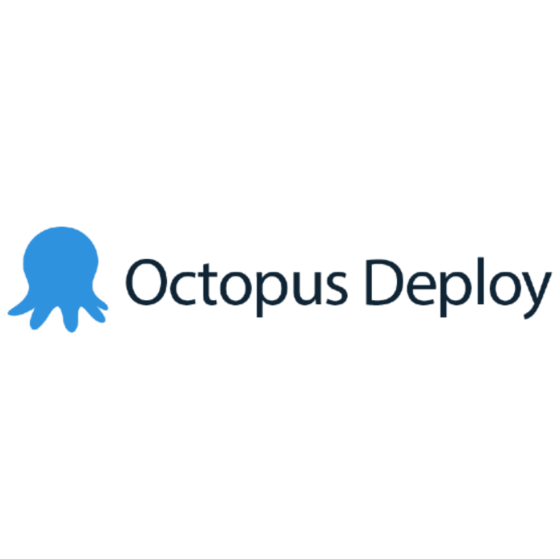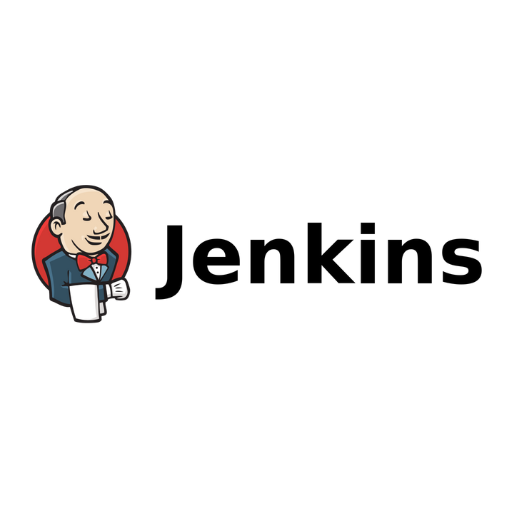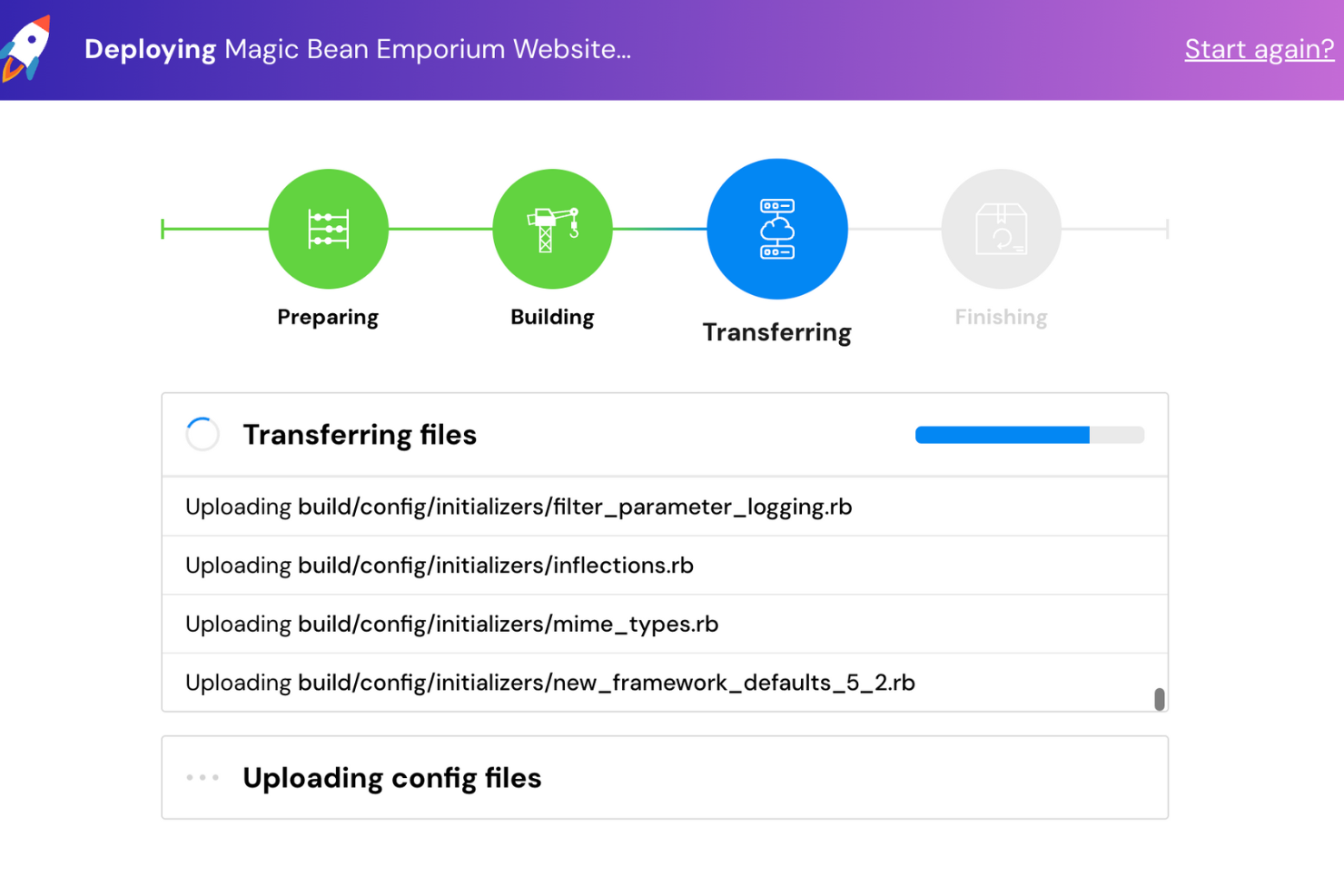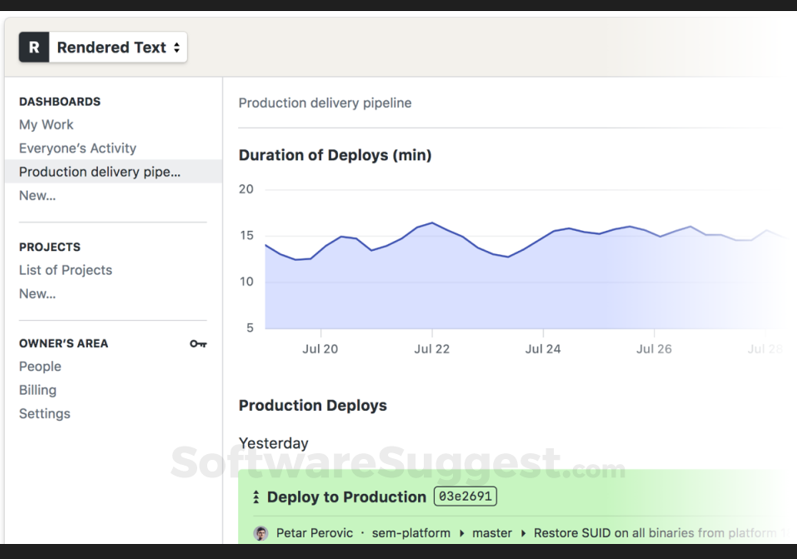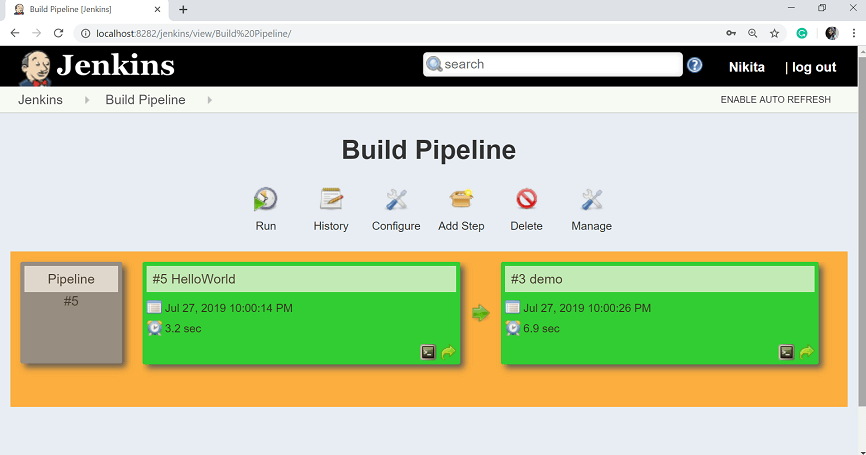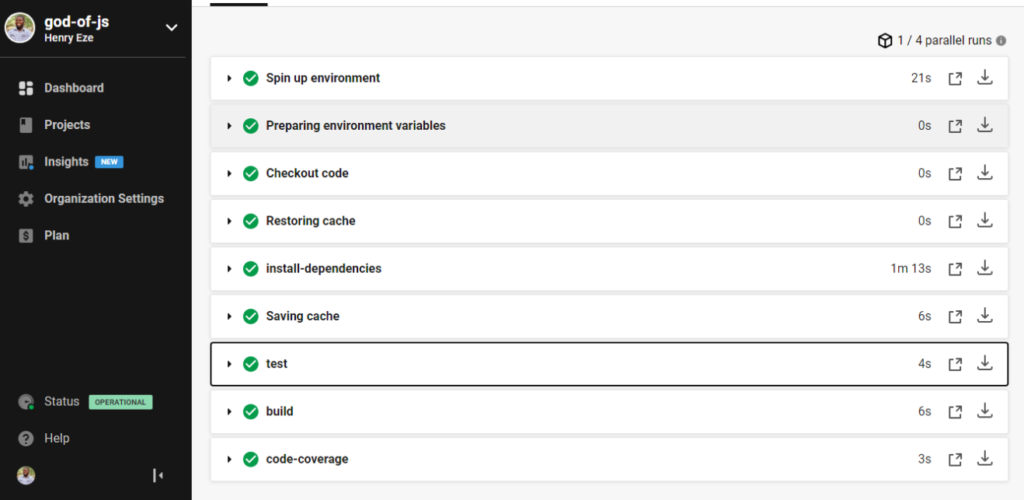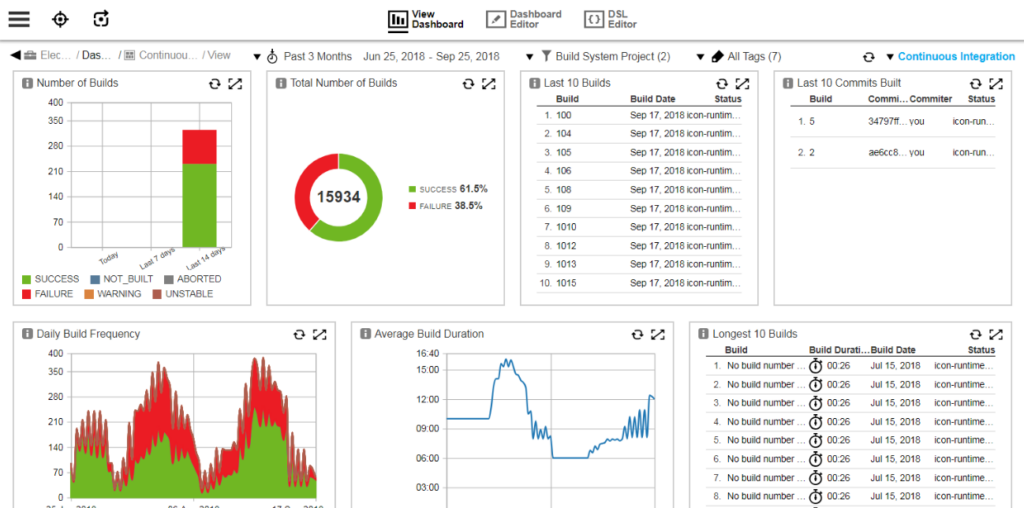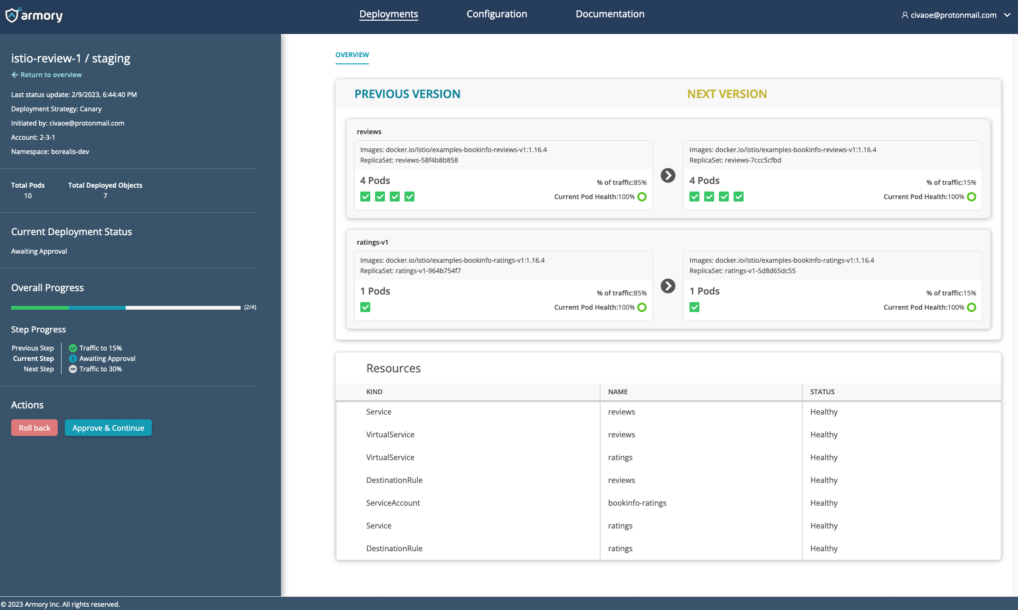10 Best Continuous Deployment Tools Shortlist
Here's my pick of the 10 best software from the 24 tools reviewed.
Our one-on-one guidance will help you find the perfect fit.
In software development, continuous deployment tools are your trusted ally. At their core, they deftly weave new features into both on-premises apps for Windows and expansive cloud-based systems. They're a beacon in managing dependencies, ensuring easy application deployments, and minimizing downtime during software releases and upgrades.
I've wrestled with the intricacies of source code, employed automation tools, and cultivated a dynamic CD platform. I've felt the weight of microservices challenges, the urgency of on-demand shifts, and the unpredictability of rollbacks. So, if you're feeling overwhelmed by unpredictable deployments or intricate dependencies, read and lean on these tools. Experience their benefits firsthand and revolutionize your software journey.
What Are Continuous Deployment Tools?
Continuous deployment tools are software platforms used to automate the stages of software development, from code integration to product deployment. Primarily utilized by software developers, DevOps teams, and IT professionals, these tools enable the consistent and automated software transition from development to testing and, ultimately, to a production environment.
With these tools, you get the precision of a continuous integration tool, the adaptability of self-hosted solutions, and the innovation of templates to perfect your delivery pipeline. This approach fosters a more efficient workflow, allowing teams to deliver updates more frequently, react to changes promptly, and align closely with business requirements and customer needs.
Best Continuous Deployment Tools Summary
| Tool | Best For | Trial Info | Price | ||
|---|---|---|---|---|---|
| 1 | Best for zero downtime deployments | Free 10-day trial | From $8/user/month (billed annually) | Website | |
| 2 | Best for automating complex deployments | 30-day free trial | From $30/user/month (billed annually) | Website | |
| 3 | Best for rapid deployment cycles | Free plan available | From $90/month | Website | |
| 4 | Best for continuous testing automation | 14-day free trial | Pricing upon request | Website | |
| 5 | Best for customizable build pipelines | Free demo available | Free to use | Website | |
| 6 | Best for flexible deployment integrations | Free plan + demo available | From $15/month | Website | |
| 7 | Best for scalable continuous delivery | Free demo available | Pricing upon request | Website | |
| 8 | Best for Atlassian environment integration | 30-day free trial | From $1,200 | Website | |
| 9 | Best for Azure platform compatibility | Not available | From $6/user/month (billed annually) | Website | |
| 10 | Best for deployment-as-a-service model | Not available | From $20/user/month | Website |
-

Docker
Visit WebsiteThis is an aggregated rating for this tool including ratings from Crozdesk users and ratings from other sites.4.6 -

Pulumi
Visit WebsiteThis is an aggregated rating for this tool including ratings from Crozdesk users and ratings from other sites.4.8 -

GitHub Actions
Visit Website
Best Continuous Deployment Tools Reviews
DeployHQ is a tool that simplifies the process of deploying websites from repositories like Git, SVN, and Mercurial to servers. It lets you connect your repositories, configure settings, and deploy your code with ease.
Why I Picked DeployHQ: It stands out as a continuous deployment tool because of its zero downtime deployments. This feature ensures that your website remains available to users even while you're deploying new changes. It prepares changes in a staging environment and launches them without affecting your live site. Additionally, DeployHQ's build pipelines support a variety of programming languages and frameworks, allowing you to automate tasks like compiling code and installing dependencies before deployment.
Another reason I chose DeployHQ is its automatic deployment capability. This feature allows you to set up automatic deployments from popular Git repositories like GitHub, GitLab, and Bitbucket. It means you can maintain a continuous integration and deployment workflow, keeping your project up-to-date without manual intervention. Deployment templates also speed up the process by providing reusable configurations, which is a huge time-saver for repetitive tasks.
Standout Features & Integrations:
DeployHQ offers features like deployment templates that allow for faster project setup by reusing configurations. Additionally, it supports deployments behind firewalls, giving you more flexibility in managing your deployment environments. It integrates with Bugsnag, Cloudflare, Codebase, Discord, Honeybadger, Microsoft Teams, New Relic, Rollbar, Sentry, Slack, HTTP POST, and GitHub.
Pros and cons
Pros:
- Offers deployment templates that help standardize processes across projects
- Supports multiple environments, allowing for more customized deployment setups
- Automates deployment processes, which saves time and reduces manual errors
Cons:
- Advanced features may require a learning curve
- Pricing can be a concern for smaller teams or individual developers
Octopus Deploy is a continuous deployment and delivery platform built to simplify complex release management workflows across on-premises, cloud, and container environments. It helps DevOps teams automate deployments, manage multiple environments, and improve software delivery reliability.
Why I Picked Octopus Deploy: I chose Octopus Deploy for its ability to automate intricate deployment tasks across diverse environments. Compared to other tools, it excels in tenant management, allowing teams to manage deployments for multiple customers simultaneously. Its built-in runbook automation, coupled with environment progression features, makes it especially effective for reducing manual errors and ensuring consistent deployments. This robust support for complex use cases makes it the Best for automating complex deployments.
Standout Features & Integrations:
Octopus Deploy includes features such as deployment automation, runbook automation for operational tasks, and tenanted deployments for supporting multiple customers at scale. Its environment progression feature helps teams move applications through dev, test, and production stages with full oversight. Octopus also supports config as code and integrates with leading CI/CD tools and cloud providers, including GitHub Actions, Jenkins, Azure DevOps, AWS, Google Cloud, Terraform, and Kubernetes.
Pros and cons
Pros:
- Strong Kubernetes and CI tool integrations
- Runbook automation reduces manual errors
- Scales across multi-tenant deployments
Cons:
- Integration depth varies across third-party tools
- Setup and onboarding can take time
Semaphore is a top tool for automating software development. It excels in CI/CD, speeding up deployment cycles by quickly moving code from repository to live environment. Developers love Semaphore for its efficiency and effectiveness.
Why I Picked Semaphore: I chose Semaphore after carefully comparing its performance with other tools in the market. I determined that Semaphore is best for rapid deployment cycles, as it consistently delivers updates and patches quickly, making it an ideal solution for teams that need to respond to changes swiftly.
Standout Features & Integrations:
Semaphore's workflow visualization and parallel execution enable developers to deploy code more efficiently, thus reducing the time between updates. Its Docker Layer Caching, automatic scaling, and lightweight agent further enhance its rapid deployment capabilities. Important integrations include GitHub, Bitbucket, Docker, Slack, and various cloud providers, creating a cohesive ecosystem for continuous deployment.
Pros and cons
Pros:
- Highly customizable parallel execution
- Integrates with popular platforms like GitHub and Docker
- Quick deployment without loss of quality
Cons:
- Limited customer support availability
- Steeper learning curve for beginners
- Pricing can be on the higher side for small teams
Tricentis is a continuous testing platform designed to automate and manage the entire testing process within a software development lifecycle.
Why I Picked Tricentis: I chose Tricentis after carefully determining its standout qualities among other testing automation platforms. Tricentis is best for continuous testing automation because of its advanced capabilities, ability to reduce manual testing effort, and adaptive nature to various testing scenarios and environments.
Standout Features & Integrations:
Tricentis offers a variety of features such as scriptless test automation, real-time insight into testing progress, and cross-platform support. These features allow for a more streamlined and efficient testing process without requiring extensive coding knowledge. The platform integrates with leading development and project management tools such as Jira, Jenkins, and Selenium, further enhancing flexibility and usefulness within an existing development ecosystem.
Pros and cons
Pros:
- Cross-platform support for various testing needs
- Integration with popular development tools
- Comprehensive automation capabilities
Cons:
- Some advanced features might be overkill for smaller projects
- May have a steeper learning curve for beginners
- Pricing information may be less transparent
Jenkins is an open-source automation server widely used to streamline the building, testing, and deployment of applications. Its powerful customization capabilities through plugins and scripting allow developers to create pipelines that suit the specific needs of their projects.
Why I Picked Jenkins: I chose Jenkins after comparing its extensive customization options and considering the opinions of various development professionals. This level of customization is why I determined that Jenkins is 'Best for...' customizable build pipelines; it allows developers to shape their channels according to the unique requirements of each project.
Standout Features & Integrations:
Jenkins offers many features such as a rich plugin architecture, pipeline-as-code, and integration with virtually all version control systems. It has a broad community that contributes plugins for different integrations, including Git, Docker, Slack, JIRA, and various cloud services. These integrations allow developers to create cohesive and automated workflows that can be finely tuned to their needs.
Pros and cons
Pros:
- Integrates well with a wide variety of tools and platforms
- Active community support and abundant resources
- Extensive customization through plugins and scripting
Cons:
- Requires careful management and can be resource-intensive on larger projects
- Some plugins may be poorly maintained
- Can be complex to set up, particularly for beginners
CircleCI is a tool designed to offer Continuous Integration and Continuous Deployment (CI/CD) capabilities. It's especially geared towards automating the process of integrating code changes and deploying applications. Because of its focused approach to both integration and deployment, CircleCI has carved a niche as the best tool for integration and deployment automation.
Why I Picked CircleCI: I chose CircleCI after a detailed analysis and comparison with other continuous deployment tools. Its emphasis on both integration and deployment processes, coupled with powerful automation features, makes it distinct. I judged it to be the best integration and deployment automation tool due to its efficiency in handling complex workflows and connecting various parts of the development process.
Standout Features & Integrations:
CircleCI offers customizable workflows, reusable commands, and jobs, which all contribute to a streamlined deployment process. Its first-class Docker support further aids in automating the build process. Key integrations include GitHub, Bitbucket, AWS, Slack, and Google Cloud, fostering a well-connected development ecosystem.
Pros and cons
Pros:
- Support for Docker and parallel execution
- Real-time feedback on the development process
- Wide array of integrations with popular tools and platforms
- Wide range of integrations with leading platforms
- Strong Docker support and customizable workflows
- Robust integration and deployment automation
Cons:
- Could be over-featured for very small or simple projects
- Configuration might be complex for some users
- May require some learning curve for newcomers
- Documentation might be overwhelming for new users
- Pricing may be a barrier for small teams
- Can become complex for smaller projects
CloudBees is a continuous delivery software platform designed to provide scalable solutions for businesses of varying sizes. With an emphasis on agility, CloudBees supports the ability to scale and adapt for scalable continuous delivery.
Why I Picked CloudBees: I chose CloudBees for this list after comparing it to various continuous delivery platforms. Its ability to scale effortlessly, coupled with an extensive array of features, caught my attention. I judged it best for scalable continuous delivery due to the ease with which it adapts to organizational growth, its extensive feature set, and its robust scalability options that align with varying business needs.
Standout Features & Integrations:
CloudBees provides features like pipeline automation, real-time analytics, and security compliance. These capabilities facilitate efficient development cycles and enhance the entire delivery process. The tool also integrates with popular platforms like GitHub, Jira, and Jenkins, creating a cohesive development environment that can evolve along with the business.
Pros and cons
Pros:
- Integrations with popular development tools
- Robust set of features for continuous delivery
- Exceptional scalability to suit different business sizes
Cons:
- Some learning curves for new users
- Pricing can be high for startups
- May be complex for smaller teams
Bamboo is a continuous integration and deployment tool that is crafted to fit into the Atlassian ecosystem. With cohesive workflow with tools like Jira and Bitbucket, Bamboo stands tall as the best option for Atlassian environment integration.
Why I Picked Bamboo: I picked Bamboo after closely evaluating its deep-rooted connection with the Atlassian environment. It's not just another deployment tool; it's one built to function harmoniously with Atlassian products. I determined Bamboo to be best for Atlassian environment integration as it brings powerful build and deployment capabilities and unifies the Atlassian suite into a more productive and collaborative experience.
Standout Features & Integrations:
Bamboo's features include automated build and test processes, deployment projects, and customized triggers. It supports numerous languages like Java and Python and testing frameworks. The real gem in Bamboo's crown is its integration with other Atlassian tools like Jira Software, Bitbucket, and Fisheye. These integrations make it an integral part of the Atlassian ecosystem, providing streamlined tracking and collaboration.
Pros and cons
Pros:
- Flexible deployment options
- Robust build and test automation capabilities
- Deep integration with Atlassian tools
Cons:
- Higher cost compared to some other continuous deployment tools
- Limited third-party integrations outside of Atlassian
- Steeper learning curve for non-Atlassian users
Microsoft Azure DevOps Server is a collaborative software development tool with a centralized version control system with integrated project management features. Its tight integration with the Azure cloud platform makes it an ideal solution for organizations that rely on Azure services, justifying the statement that it's best for Azure platform compatibility.
Why I Picked Microsoft Azure DevOps Server: After judging and comparing various development tools focusing on Azure compatibility, I chose Microsoft Azure DevOps Server. In my opinion, it's 'Best for...' Azure platform compatibility, as it leverages the inherent strengths and services of Azure, providing a cohesive development experience.
Standout Features & Integrations:
Microsoft Azure DevOps Server offers features like version control, reporting, requirements management, project management, automated builds, and release management. Integrating with other Microsoft products like Visual Studio, Microsoft Teams, and Power BI enhances collaboration and data analytics.
Pros and cons
Pros:
- Availability of extensions for third-party integrations
- Extensive project management and development capabilities
- Integration with Azure and other Microsoft services
Cons:
- Potential limitations for those not heavily invested in the Azure platform
- Steeper learning curve if not familiar with Microsoft’s ecosystem
- Might be overwhelming for small teams or individual developers
Armory is a continuous delivery platform that enables businesses to deploy software quickly and efficiently across cloud environments. The platform's focus on deployment-as-a-service automates and simplifies deployment processes.
Why I Picked Armory: I chose Armory because of its dedication to the deployment-as-a-service model, having compared it with other platforms on the market. Its emphasis on continuous integration and delivery and support for various cloud providers makes it stand out in the field. This unique focus on deployment-as-a-service and the provided support for collaboration across different teams makes it the 'Best for...' deployment-as-a-service model.
Standout Features & Integrations:
Armory offers robust deployment features like automated canary analysis, single-pane-of-glass visibility, and support for multi-cloud environments. It integrates with popular CI/CD tools, cloud providers, and container orchestration platforms, including Jenkins, AWS, Google Cloud, and Kubernetes, providing a deployment experience.
Pros and cons
Pros:
- Strong support for deployment-as-a-service model
- Integration with popular CI/CD tools and container orchestration platforms
- Flexible deployment options across different cloud providers
Cons:
- Limited documentation and community support compared to more established platforms
- Some features might require a steep learning curve
- Pricing may be high for smaller organizations
Other Noteworthy Continuous Deployment Tools
Below is a list of additional continuous deployment tools that I shortlisted but did not make it to the top 10. Definitely worth checking them out.
- Argo CD
For Kubernetes-native deployments
- NinjaOne
For streamlined software deployment
- ManageEngine Endpoint Central
For unified endpoint management
- GitHub
Good for version control and community-driven development
- Split
Good for controlled feature rollouts
- Gearset
Good for Salesforce DevOps automation
- Spinnaker
Good for multi-cloud continuous delivery
- TeamCity
Good for extensible and customizable continuous integration
- LaunchDarkly
Good for feature flag management
- Drone CI
Good for container-native continuous integration
- Flosum
Good for native Salesforce application lifecycle management
- Travis CI
Good for continuous integration in open-source projects
- Buildkite
Good for scalable and flexible build automation
- GitLab
Good for continuous integration and collaboration
Other Continuous Deployment Tools-Related Reviews
Selection Criteria for Choosing Continuous Deployment Tools
When selecting the ideal continuous integration/continuous delivery (CI/CD) and deployment software, there are several key considerations to remember. Here's a detailed breakdown of the specific criteria that matter most for these particular types of software.
Core Functionality
- Continuous Integration: The tool must enable automated code integration and testing.
- Continuous Deployment: Easy and automatic deployment to various environments.
- Version Control: Ability to manage different versions of the code.
- Scalability: Capability to grow with the needs of the project.
- Multi-Platform Support: Support for deploying across different platforms and environments.
Key Features
- Automation: Facilitates automated building, testing, and deployment, saving time and reducing human errors.
- Collaboration Tools: Features that enhance collaboration among team members, such as shared workspaces or real-time editing.
- Integration with Existing Tools: Compatibility with existing development and operational tools.
- Security and Compliance: Tools to ensure that code and deployment meet security standards and compliance regulations.
- Monitoring and Reporting: Provides insights into the performance and health of the deployment through visualizations and alerts.
Usability
- Intuitive Interface: A straightforward and easy-to-navigate interface that allows for quick onboarding and a reduced learning curve.
- Customizable Workflows: The ability to tailor the deployment workflow to suit the project’s unique requirements.
- Role-Based Access Control: Easy configuration of access controls based on team roles and responsibilities.
- Knowledge Base or Learning Library: Availability of comprehensive documentation, tutorials, and support to help onboard users and resolve issues.
- Customer Support: Responsive and knowledgeable customer support that can assist in troubleshooting and best practices.
Most Common Questions Regarding Continuous Deployment Tools (FAQs)
What are the benefits of using continuous deployment tools?
Continuous deployment tools offer several advantages, including:
- Automated Deployments: They automate the deployment process, reducing manual errors and speeding up release cycles.
- Increased Collaboration: By integrating various stages of development, they enhance collaboration among developers, testers, and operations teams.
- Real-time Monitoring: They provide real-time insights into the deployment process, allowing for immediate detection and correction of issues.
- Scalability: These tools can quickly scale with the project’s growth, supporting large and complex deployment needs.
- Compliance and Security: They help maintain compliance with industry standards and ensure that the deployed code meets security requirements.
How much do continuous deployment tools typically cost?
Continuous deployment tools follow different pricing models. Some are priced based on the number of users, while others charge based on the number of build minutes or deployment pipelines. The typical range of pricing can vary widely from as low as $10/user/month to hundreds of dollars per month, depending on the features and scale of the project.
What is the cheapest and most expensive continuous deployment software?
The most affordable options often include open-source tools like Jenkins, which can be free but may require more configuration and maintenance. Conversely, enterprise-level solutions like IBM UrbanCode Deploy can be more expensive, costing several hundred dollars per user per month, catering to larger and more complex deployments.
Are there any free tool options for continuous deployment?
Yes, there are free options available for continuous deployment. Open-source tools like Jenkins, GitLab CI/CD pipeline (in their community editions), and Travis CI (for open-source projects) offer free options. However, these may require more technical expertise to set up and maintain.
What are the typical pricing models for continuous deployment tools?
Pricing models for continuous deployment tools can vary. Common models include:
- Per User: Charging is based on the number of users accessing the tool.
- Per Build Minute: Billing according to the minutes used for building and deploying.
- Subscription Plans: Offering tiered subscription plans with different features and support levels.
- Custom Pricing: Tailoring the pricing based on the specific needs and scale of the organization.
How do continuous deployment tools integrate with existing development environments?
Most continuous deployment tools offer integrations with popular development environments, version control systems, and other DevOps tools. This allows for a workflow from coding to deployment, aligning with the tools the development team uses.
Is training required to use continuous deployment tools?
Training requirements can vary among different continuous deployment tools. Some tools are designed with ease of use in mind and offer intuitive interfaces, while others may require more in-depth training. Many providers offer documentation, tutorials, and customer support to assist in onboarding.
Can continuous deployment tools be customized to fit specific needs?
Many continuous deployment tools offer customizable workflows, allowing organizations to tailor the deployment process to fit their unique requirements and standards. This customization can include defining specific deployment stages, integrating with special tools, and setting up custom notifications and reporting.
Summary
Continuous deployment tools are essential in modern software development, automating the deployment process and fostering collaboration among different teams. As you consider the best tool for your use case, the following key takeaways may guide your decision:
- Understand Your Needs: Assess the core functionality and key features that align with your specific deployment requirements. Consider factors like scalability, compliance, real-time monitoring, and integration capabilities.
- Evaluate Pricing Carefully: Continuous deployment tools follow various pricing models, ranging from free, open-source solutions to enterprise-level pricing. Understanding the pricing structure, including any additional fees or requirements, will help you select a tool that fits your budget.
- Consider Usability and Support: Look for tools that offer an intuitive user interface and robust customer support. The complexity of configuration, available training resources, and community support can significantly impact the tool's effectiveness and your team's ability to utilize it fully.
Join for More Insights
Boost your SaaS growth and leadership skills. Subscribe to our newsletter for the latest insights from CTOs and aspiring tech leaders. We'll help you scale smarter and lead stronger with guides, resources, and strategies from top experts!



